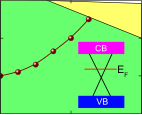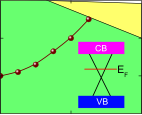Optimizing Topological Insulators
3D topological insulators comprise a class of materials that have gapless surface states on top of an insulating ground state in the bulk. Any transport measurement of these surface states is influenced by the transport properties of the bulk. We can minimize the contribution of the bulk if we can make it a better insulator. However, none of the commonly known 3D topological insulators is a good insulator.
In a paper in Physical Review B, Zhi Ren and colleagues at Osaka University, Japan, demonstrate a way to make better insulators without destroying the gapless surface states. The authors fabricated single crystals using bismuth ( Bi), antimony ( Sb), tellurium ( Te), and selenium ( Se) with variable concentrations of each element. They ensured that the samples preserved the crystal structure of Bi2Te3, a prototypical 3D topological insulator. By changing the amount of each element, they managed to decrease the number of free charge carriers in the bulk, thereby making a better insulator. With this control over the property of the bulk, the authors pinpointed the contribution of the surface states in the transport measurements. The paper further suggests that the use of thinner samples may lead to easier identification of these topological surface states. – Hari Dahal





